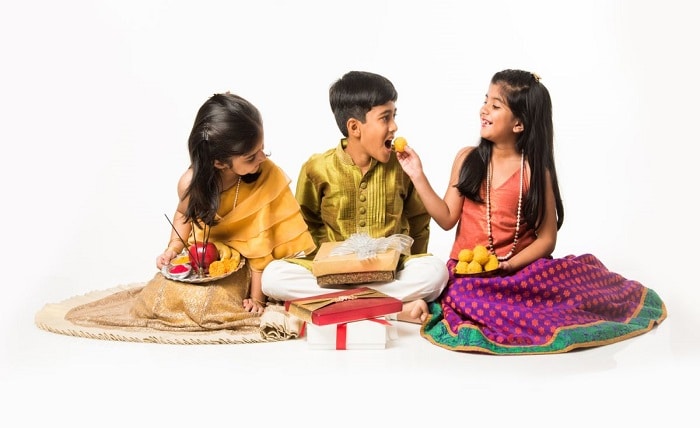Bhai Dooj 2022: Everything You Need to Know About the Festival of Sibling Love

Bhai dooj is one of the most awaited and cherished festivals in India, especially for brothers and sisters. It is a day when sisters pray for the well-being and prosperity of their brothers, and brothers promise to protect and support their sisters. Bhai dooj is also known by different names in different regions, such as bhaiya dooj, bhai bij, bhai phonta, bhai tika, and bhau beej. Bhai dooj is celebrated on the second day of the Shukla Paksha of the Kartik month, which is usually in October or November. In 2022, Bhai dooj will be celebrated on October 26. Bhai dooj is a festival that symbolizes the love, affection, and respect between siblings, and strengthens their bond. In this blog post, we will explore the various aspects of bhai dooj 2022, such as its date, time, history, significance, rituals, and stories.
Date and Time of Bhai Dooj 2022
According to the Hindu calendar, bhai dooj is celebrated on the second day or Dwitiya tithi of the Shukla Paksha of the Kartik month. This day falls two days after Diwali, the festival of lights. In 2022, bhai dooj will be celebrated on Wednesday, October 26. The Dwitiya tithi will begin at 2:42 pm on October 26, and end at 12:45 pm on October 27. The most auspicious time or shubh muhurat for applying the tilak or the vermillion mark on the brother’s forehead by the sister is between 4:17 pm and 5:41 pm on October 26. The bhai dooj aprahana time, which is the best time for performing the puja or the worship, is between 1:12 pm and 3:27 pm on October 26. However, some people may also celebrate bhai dooj on October 27, as there will be Udaya tithi or the sunrise tithi on this day. The shubh choghadiya or the auspicious time for applying the tilak on October 27 is between 6:29 am and 6:53 am, 12:04 pm and 2:52 pm, and 4:16 pm and 5:40 pm.
History and Significance of Bhai Dooj
Bhai dooj is a festival that has a long and rich history and significance in the Hindu culture and mythology. There are many legends and stories associated with the origin and celebration of bhai dooj. Some of the most popular ones are:
- The story of Yama and Yamuna: According to this story, Yama, the god of death, and Yamuna, the river goddess, were brother and sister. Yama did not visit his sister for a long time, despite her repeated invitations and offers of food. One day, he decided to visit her on the second day of the Shukla Paksha of the Kartik month. Yamuna was overjoyed to see her brother and welcomed him with sweets and flowers. She applied a tilak on his forehead and prayed for his long life and happiness. Yama was touched by his sister’s love and affection and asked her to ask for a boon. Yamuna wished that he would visit her every year on this day, and that any sister who performs the same ritual for her brother would never fear death. Yama granted her wish and blessed her. Since then, this day is celebrated as bhai dooj, and sisters pray for their brothers’ longevity and prosperity.
- The story of Krishna and Subhadra: According to this story, Krishna, the eighth avatar of Vishnu, and Subhadra, his sister, were very close and fond of each other. After killing the demon king Narakasura, Krishna visited his sister Subhadra, who gave him a warm welcome with sweets and flowers. She applied a tilak on his forehead and wished him success and victory. Krishna was pleased by his sister’s gesture and gave her gifts and blessings. Since then, this day is celebrated as bhai dooj, and sisters apply tilak on their brothers’ forehead and wish them well.
- The story of Mahavira and Sudarshana: According to this story, Mahavira, the 24th Tirthankara or the spiritual teacher of Jainism, and Sudarshana, his sister, were very devoted and respectful to each other. Mahavira attained nirvana or liberation on the day of Diwali, and his followers celebrated his enlightenment with joy and gratitude. The next day, Sudarshana visited her brother’s disciples and applied tilak on their forehead and offered them food. She also requested them to protect and guide her brother’s teachings and followers. The disciples were impressed by her faith and dedication and accepted her as their sister. Since then, this day is celebrated as bhai dooj, and sisters apply tilak on their brothers’ forehead and offer them food.
Bhai dooj is a festival that signifies the love, affection, and respect between siblings, and strengthens their bond. It is a day when sisters pray for their brothers’ well-being and prosperity, and brothers promise to protect and support their sisters. Bhai dooj is also a day when siblings express their gratitude and appreciation for each other, and share their joys and sorrows. Bhai dooj is a festival that celebrates the essence and beauty of the sibling relationship, and fosters harmony and peace in the family and society.
Rituals and Traditions of Bhai Dooj
Bhai dooj is a festival that is celebrated with various rituals and traditions in different parts of India. Some of the common rituals and traditions of bhai dooj are:
- The preparation: Before the day of bhai dooj, sisters prepare for the festival by buying or making sweets, gifts, and decorations for their brothers. They also clean and decorate their homes and puja rooms with rangoli, flowers, lamps, and candles. They also fast or observe a vrat for their brothers’ long life and happiness.
- The tilak ceremony: On the day of bhai dooj, sisters apply a tilak or a vermillion mark on their brothers’ forehead, along with rice grains, sandalwood paste, and roli. The tilak symbolizes the sister’s love and prayers for her brother, and the brother’s protection and support for his sister. The sisters also perform an aarti or a ritual of waving a lamp in front of their brothers, and chant mantras or prayers for their well-being and prosperity. The brothers also apply a tilak on their sisters’ forehead, and bless them with happiness and success.
- The exchange of gifts: After the tilak ceremony, sisters offer sweets, fruits, and dry fruits to their brothers, and feed them with their own hands. They also give them gifts, such as clothes, accessories, or money, as a token of their love and affection. The brothers also offer sweets, fruits, and dry fruits to their sisters, and give them gifts, such as jewelry, cosmetics, or money, as a token of their gratitude and appreciation. The exchange of gifts symbolizes the sharing and caring between siblings, and the strengthening of their bond.
- The storytelling: After the exchange of gifts, siblings sit together and listen to or narrate the stories and legends of bhai dooj, and the significance and importance of the festival. They also recall and share their childhood memories and experiences, and their joys and sorrows. They also tease and joke with each other, and have fun and laughter. The storytelling symbolizes the communication and understanding between siblings, and the fostering of their friendship and companionship.
Stories and Legends of Bhai Dooj
Bhai Dooj is a festival that celebrates the bond between brothers and sisters. It has many stories and legends associated with it, which explain its origin and significance. Here are some of the most popular and interesting stories and legends of Bhai Dooj:
- The story of Yama and Yamuna: According to this story, Yama, the god of death, and Yamuna, the river goddess, were brother and sister. Yama did not visit his sister for a long time, despite her repeated invitations and offers of food. One day, he decided to visit her on the second day of the Shukla Paksha of the Kartik month. Yamuna was overjoyed to see her brother and she welcomed him with sweets and flowers. She applied a tilak on his forehead and prayed for his long life and happiness. Yama was touched by his sister’s love and affection and asked her to ask for a boon. Yamuna wished that he would visit her every year on this day, and that any sister who performs the same ritual for her brother would never fear death. Yama granted her wish and blessed her. Since then, this day is celebrated as Bhai Dooj, and sisters pray for their brothers’ longevity and prosperity.
- The story of Krishna and Subhadra: According to this story, Krishna, the eighth avatar of Vishnu, and Subhadra, his sister, were very close and fond of each other. After killing the demon king Narakasura, Krishna visited his sister Subhadra, who gave him a warm welcome with sweets and flowers. She applied a tilak to his forehead and wished him success and victory. Krishna was pleased by his sister’s gesture and gave her gifts and blessings. Since then, this day is celebrated as Bhai Dooj, and sisters apply tilak to their brothers’ foreheads and wish them well.
- The story of Mahavira and Sudarshana: According to this story, Mahavira, the 24th Tirthankara, or the spiritual teacher of Jainism, and Sudarshana, his sister, were very devoted and respectful to each other. Mahavira attained nirvana, or liberation, on the day of Diwali, and his followers celebrated his enlightenment with joy and gratitude. The next day, Sudarshana visited her brother’s disciples, applied tilak to their foreheads, and offered them food. She also requested them to protect and guide her brother’s teachings and followers. The disciples were impressed by her faith and dedication and accepted her as their sister. Since then, this day is celebrated as Bhai Dooj, and sisters apply tilak on their brothers’ forehead and offer them food.
Conclusion
Bhai dooj is a Hindu festival that celebrates the bond between brothers and sisters. It falls on the second day of the Shukla Paksha of the Kartik month, which is usually in October or November. In 2022, bhai dooj will be celebrated on October 26. Bhai dooj is also known by different names in different regions, such as bhaiya dooj, bhai bij, bhai phonta, bhai tika, and bhau beej. Bhai dooj is a festival that symbolizes the love, affection, and respect between siblings, and strengthens their bond. It is a day when sisters pray for their brothers’ well-being and prosperity, and brothers promise to protect and support their sisters. Bhai dooj is also a day when siblings express their gratitude and appreciation for each other, and share their joys and sorrows. Bhai dooj is a festival that celebrates the essence and beauty of the sibling relationship, and fosters harmony and peace in the family and society.
FAQs
- Q: When is bhai dooj in 2022?
A: Bhai dooj in 2022 will be celebrated on Wednesday, October 26. The Dwitiya tithi will begin at 2:42 pm on October 26, and end at 12:45 pm on October 27. The most auspicious time or shubh muhurat for applying the tilak or the vermillion mark on the brother’s forehead by the sister is between 4:17 pm and 5:41 pm on October 26. The bhai dooj aprahana time, which is the best time for performing the puja or the worship, is between 1:12 pm and 3:27 pm on October 26.
- Q: What are the rituals and traditions of bhai dooj?
A: The rituals and traditions of bhai dooj are as follows:
- The preparation: Before the day of bhai dooj, sisters prepare for the festival by buying or making sweets, gifts, and decorations for their brothers. They also clean and decorate their homes and puja rooms with rangoli, flowers, lamps, and candles. They also fast or observe a vrat for their brothers’ long life and happiness.
- The tilak ceremony: On the day of bhai dooj, sisters apply a tilak or a vermillion mark on their brothers’ forehead, along with rice grains, sandalwood paste, and roli. The tilak symbolizes the sister’s love and prayers for her brother, and the brother’s protection and support for his sister. The sisters also perform an aarti or a ritual of waving a lamp in front of their brothers, and chant mantras or prayers for their well-being and prosperity. The brothers also apply a tilak on their sisters’ forehead, and bless them with happiness and success.
- The exchange of gifts: After the tilak ceremony, sisters offer sweets, fruits, and dry fruits to their brothers, and feed them with their own hands. They also give them gifts, such as clothes, accessories, or money, as a token of their love and affection. The brothers also offer sweets, fruits, and dry fruits to their sisters, and give them gifts, such as jewelry, cosmetics, or money, as a token of their gratitude and appreciation. The exchange of gifts symbolizes the sharing and caring between siblings, and the strengthening of their bond.
- The storytelling: After the exchange of gifts, siblings sit together and listen to or narrate the stories and legends of bhai dooj, and the significance and importance of the festival. They also recall and share their childhood memories and experiences, and their joys and sorrows. They also tease and joke with each other, and have fun and laughter. The storytelling symbolizes the communication and understanding between siblings, and the fostering of their friendship and companionship.
- Q: What are the stories and legends of bhai dooj?
A: There are many stories and legends associated with the origin and celebration of bhai dooj. Some of the most popular ones are:
- The story of Yama and Yamuna: According to this story, Yama, the god of death, and Yamuna, the river goddess, were brother and sister. Yama did not visit his sister for a long time, despite her repeated invitations and offers of food. One day, he decided to visit her on the second day of the Shukla Paksha of the Kartik month. Yamuna was overjoyed to see her brother, and she welcomed him with sweets and flowers. She applied a tilak on his forehead and prayed for his long life and happiness. Yama was touched by his sister’s love and affection, and asked her to ask for a boon. Yamuna wished that he would visit her every year on this day, and that any sister who performs the same ritual for her brother would never fear death. Yama granted her wish and blessed her. Since then, this day is celebrated as bhai dooj, and sisters pray for their brothers’ longevity and prosperity.
- The story of Krishna and Subhadra: According to this story, Krishna, the eighth avatar of Vishnu, and Subhadra, his sister, were very close and fond of each other. After killing the demon king Narakasura, Krishna visited his sister Subhadra, who gave him a warm welcome with sweets and flowers. She applied a tilak on his forehead and wished him success and victory. Krishna was pleased by his sister’s gesture and gave her gifts and blessings. Since then, this day is celebrated as bhai dooj, and sisters apply tilak on their brothers’ forehead and wish them well.
- The story of Mahavira and Sudarshana: According to this story, Mahavira, the 24th Tirthankara or the spiritual teacher of Jainism, and Sudarshana, his sister, were very devoted and respectful to each other. Mahavira attained nirvana or liberation on the day of Diwali, and his followers celebrated his enlightenment with joy and gratitude. The next day, Sudarshana visited her brother’s disciples, applied tilak on their forehead and offered them food. She also requested that they protect and guide her brother’s teachings and followers. The disciples were impressed by her faith and dedication and accepted her as their sister. Since then, this day is celebrated as bhai dooj, and sisters apply tilak on their brothers’ foreheads and offer them food.
- Q: What are the benefits of celebrating bhai dooj?
A: Some of the benefits of celebrating Bhai Dooj are:
- It enhances the love, affection, and respect between siblings and strengthens their bond.
- It expresses gratitude and appreciation for each other and shares joys and sorrows.
- It celebrates the essence and beauty of the sibling relationship and fosters harmony and peace in the family and society.
- It preserves and promotes cultural and religious values and traditions and connects the past and the present.
- It brings happiness and prosperity to the siblings and their families, and it protects them from evil and misfortune.
- Q: What are some alternatives to bhai dooj for celebrating the sibling bond?
A: Some alternatives to bhai dooj for celebrating the sibling bond are:
- Raksha Bandhan: Raksha Bandhan is another Hindu festival that celebrates the bond between brothers and sisters. It falls on the full moon day of the Shravan month, which is usually in August. On this day, sisters tie a sacred thread, or rakhi, on their brothers’ wrists and pray for their well-being and prosperity. Brothers promise to protect and support their sisters and give them gifts and blessings.
- Siblings Day: Siblings Day is an international festival that celebrates the bond between siblings. It falls on April 10 every year. On this day, siblings express their love and appreciation for each other and share their memories and experiences. They also exchange gifts and greetings and spend quality time together.
- Siblings Week: Siblings Week is a week-long festival that celebrates the bond between siblings. It falls on the first week of May every year. This week, siblings engage in various activities and events, such as games, sports, arts, crafts, music, movies, and outings. They also honor and recognize the achievements and contributions of their siblings, and they support and encourage them.




